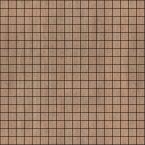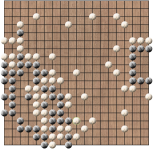Games
Go Rules
Overview
These rules are a brief summary for those already familiar with the game. They will be expanded with more detail in the future.
Go is a two-player game whose object is to capture more territory than your opponent. Players capture territory by surrounding regions of the board with strings of stones. In their battles to control territory, players may capture enemy stones by surrounding them with friendly stones. Your captured pieces count against your final score.
Igfip™ implements roughly Japanese Go rules, which we attempt to summarize here. The major exception is scoring with relation to Komi and handicap stones. Full conformance with Japanese rules may be implemented depending on the outcome of discussions on the Go forum.
Board
The standard Go board size is 19x19. In addition to the standard size, Igfip™ supports a range of smaller board sizes.


Pieces
Each player starts with no pieces on the board, but has an unlimited supply of pieces to place on the board.
Rules
- Black moves first.
- Only one piece may be placed at a time, with players alternating moves.
- After a move, any group of pieces that is completely surrounded by immediately adjacent opposing pieces is removed from the board. You may not place a piece so as to result in the capture of your own stones.
- You may not make a move that recreates a previous board position with the same player to play. This is known as Ko and happens when players can repeatedly capture a piece at the same location on each successive move.
- You may opt to pass instead of making a move.
- The game ends after two consecutive passes.
- The player with the most territory at the end of the game wins. Your total territory is counted by subtracting the number of your captured pieces (including dead stones in enemy territory) from the territory you control. Each surrounded intersection counts as one point of territory.
Go Help
Legend
| Unselected | Selected or Moved |
|---|
Piece Placement
Place a piece by clicking on an empty board space.
Captured Piece Count
A running total of captured pieces for each side is displayed above the upper left-hand corner of the board. The captured piece count is provided to help players estimate their scores by subtracting the count from captured territory, but it is not the actual score.
Pass
Players may pass a turn by pressing the Pass button below the lower left-hand corner of the board. When your opponent passes a turn, you will be notified by a message window.
Hoshi/Handicap Stone Placement
The user interface does not currently provide a means to specify a number of handicap stones and place them automatically. You may place handicap stones manually and ask your opponent to pass until the last handicap stone has been placed.
Ending the Game
The game ends after two consecutive passes.
Scoring
At the end of the game, the captured piece display changes to show the final score of the game. Igfip™ uses Japanese scoring rules, but does not implement Komi, so ties are possible and White does not receive 5 1/2 points in a non-handicap game. This will change pending discussion on the Go forum.
Determining the final score is computationally expensive. Therefore, only an estimated score is calculated at the end of a game, which should be correct in most cases. After more computational resources are deployed, Igfip™ will compute exact scores. A human-arbitrated scoring system will be provided for tournaments to ensure the correct winner is declared.
Redraw Board
If you make an adjustment to your Web browser—such as changing your font size—while playing, the game pieces may no longer align correctly with the board. To restore proper alignment, select the Redraw command from the Go menu.©2011 Savarese Software Research Corporation
Igfip™ is a trademark of Savarese Software Research Corporation.